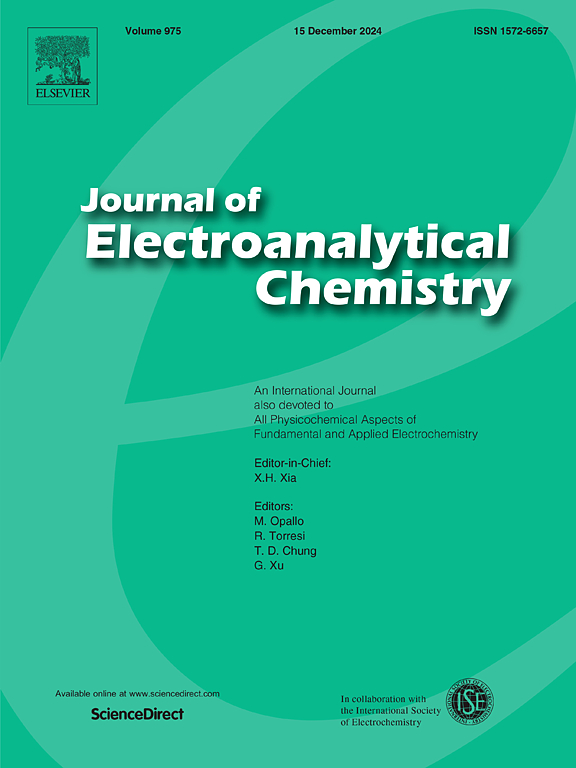A novel molybdenum disulfide (MoS2)-biopolymer-coated screen-printed carbon electrode for rapid and simple detection of manganese ions in water
IF 4.1
3区 化学
Q1 CHEMISTRY, ANALYTICAL
引用次数: 0
Abstract
Monitoring manganese ions (Mn2+) in drinking water is crucial for public health and water quality management. Mn2+ can cause discoloration, odor, or taste in tap water at concentrations above 0.05 mg L−1 which is the U.S. Environmental Protection Agency's (EPA) secondary maximum contaminant level (SMCL). In this study, a novel molybdenum disulfide (MoS2)-biopolymer-coated electrochemical electrode was developed for rapid and sensitive Mn2+ detection in water. The electrode, fabricated by electrodepositioning MoS2 and chitosan onto screen-printed carbon electrode (SPCE), demonstrated a low detection limit of 1.03 μg L−1 in 0.2 M acetate buffer solution (pH 4.5) using square wave adsorptive cathodic stripping voltammetry (SWAdCSV) with the optimized operational parameters: a deposition potential of +0.9 V, a deposition time of 300 s, an amplitude of 75 mV, and a frequency of 50 Hz. Simplified calibration curves were developed to reduce the need for frequent recalibrations, enabling practical applications in diverse water sources. Tests using real water samples achieved recoveries of 94–107 %, confirming the electrode's field applicability. This eco-friendly and cost-effective electrode provides a viable alternative to traditional laboratory-based spectrometric methods for Mn2+ monitoring, offering high sensitivity, portability, and potential widespread environmental applications.

一种新型的二硫化钼(MoS2)-生物聚合物包覆的丝网印刷碳电极用于水中锰离子的快速和简单检测
监测饮用水中的锰离子(Mn2+)对公共卫生和水质管理至关重要。当Mn2+浓度超过美国环境保护署(EPA)的二级最大污染物水平(SMCL) 0.05 mg L - 1时,自来水中的Mn2+会引起变色、气味或味道。在这项研究中,开发了一种新型的二硫化钼(MoS2)-生物聚合物包覆的电化学电极,用于快速灵敏地检测水中的Mn2+。采用方波吸附阴极溶出伏安法(SWAdCSV)在0.2 M醋酸盐缓冲溶液(pH 4.5)中,以+0.9 V的沉积电位、300 s的沉积时间、75 mV的振幅和50 Hz的频率为优化的工作参数制备了MoS2和壳聚糖电极。开发了简化的校准曲线,以减少频繁重新校准的需要,使各种水源的实际应用成为可能。使用真实水样进行的测试获得了94 - 107%的回收率,证实了电极的现场适用性。这种环保且具有成本效益的电极为传统的基于实验室的Mn2+监测光谱方法提供了可行的替代方案,具有高灵敏度,便携性和潜在的广泛环境应用。
本文章由计算机程序翻译,如有差异,请以英文原文为准。
求助全文
约1分钟内获得全文
求助全文
来源期刊
CiteScore
7.80
自引率
6.70%
发文量
912
审稿时长
2.4 months
期刊介绍:
The Journal of Electroanalytical Chemistry is the foremost international journal devoted to the interdisciplinary subject of electrochemistry in all its aspects, theoretical as well as applied.
Electrochemistry is a wide ranging area that is in a state of continuous evolution. Rather than compiling a long list of topics covered by the Journal, the editors would like to draw particular attention to the key issues of novelty, topicality and quality. Papers should present new and interesting electrochemical science in a way that is accessible to the reader. The presentation and discussion should be at a level that is consistent with the international status of the Journal. Reports describing the application of well-established techniques to problems that are essentially technical will not be accepted. Similarly, papers that report observations but fail to provide adequate interpretation will be rejected by the Editors. Papers dealing with technical electrochemistry should be submitted to other specialist journals unless the authors can show that their work provides substantially new insights into electrochemical processes.

 求助内容:
求助内容: 应助结果提醒方式:
应助结果提醒方式:


